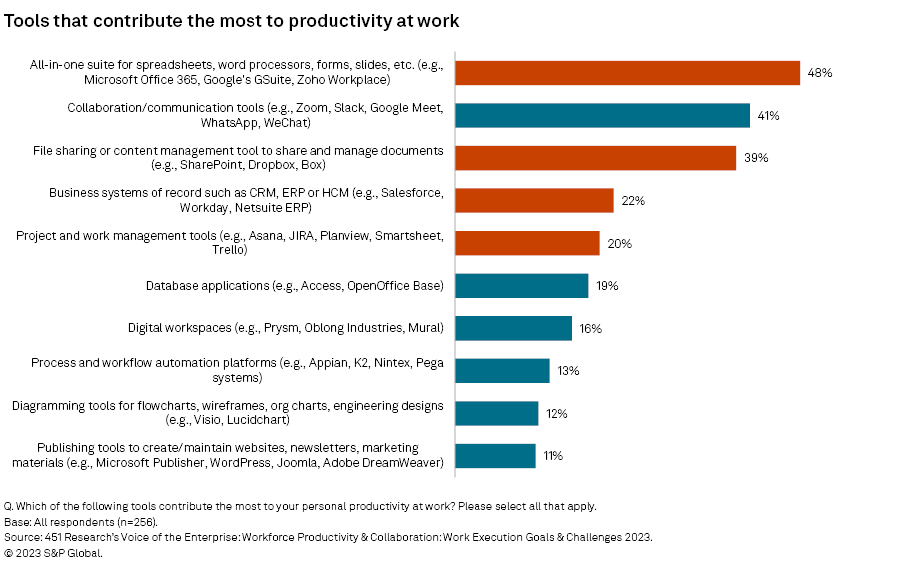S&P Global Offerings
Featured Topics
Featured Products
Events
S&P Global Offerings
Featured Topics
Featured Products
Events
S&P Global Offerings
Featured Topics
Featured Products
Events
Banking & Capital Markets
Economy & Finance
Energy Transition & Sustainability
Technology & Innovation
Podcasts & Newsletters
Banking & Capital Markets
Economy & Finance
Energy Transition & Sustainability
Technology & Innovation
Podcasts & Newsletters
S&P Global Offerings
Featured Topics
Featured Products
Events
Research — 13 Sep, 2023
There is no denying that the hype around generative AI — a technology known for being able to generate complete pieces of content or gather relevant data and information from a short prompt — has thrust discussion about possible use cases for the technology into the limelight. This prominence has undoubtedly been aided by Microsoft Corp. 's $10 billion investment in ChatGPT-maker OpenAI LLC . As this investment shows, there is huge enterprise potential for the technology, and software vendors are racing to release their own generative AI (GenAI) products or partner with an established brand.
With the technology's deep connection to content, any software category related to document creation and management could benefit from the growth of generative AI. In this report, we examine five use cases with the potential to impact worker productivity and collaboration over the next few years.

Demand for automation among knowledge workers is high, and generative AI holds the promise of bringing practical automation to the tools and technologies most associated with knowledge work execution and productivity (including content and document tools), according to 451 Research's Voice of the Enterprise survey data. In addition to helping end users more quickly generate a document or a piece of content, this technology should help summarize the content for better knowledge management and can aggregate the collaborative actions taken within it to clarify the stage of a project. Still, vendors must tread lightly as expectations for AI output remain relatively high and erroneous responses could impact customer perception of the brand and product. There is also a contingent of users who simply do not trust the accuracy of AI predictions, and if they hold sway over the buying process, this could impede adoption.

Demand for automation
Knowledge workers want more automation, according to 451 Research's Voice of the Enterprise: Workforce Productivity & Collaboration, Work Execution Goals & Challenges 2023 survey. In that survey, we asked knowledge workers, in terms of the tools and technologies they use at work, what improvement would most benefit their performance and the top response (41%) was "Ways to reduce common, repetitive types of work." We also asked users about the top benefits they believe automation will help them with. The top three responses were:
– Productivity: Getting things done faster (54%).
– Time: Saving time to allow me to do more of what I do (46%).
– Accuracy: Performing tasks more consistently with fewer errors (41%).
In addition to enhancing productivity and performance, automation stands to deepen employee engagement. In a regression analysis we performed on data from our Voice of the Enterprise: Workforce Productivity & Collaboration, Employee Engagement 2022 survey, we found the response "My work tools help me accomplish my priorities faster so I have more time to think creatively and stay ahead of projects" to be one of a handful of statistically significant drivers of positive engagement among many different variables included in the analysis.
If the demand is there and the impact is broad, vendors should focus their initial GenAI efforts on the tools most associated with productivity. According to data from our Work Execution survey, a significant number of content and document tools are associated with work productivity.

When it comes to these tools, documents and similar content types stand to benefit greatly from GenAI investments. Let's examine the top five initial use cases.
Document generation
Generative AI's calling card is content generation, and helping users create documents based on a simple prompt or approval should go far in removing the friction associated with repetitive tasks. Based on the data sets that the models in the GenAI tools have been trained on, this particular use case could extend across nearly every department in an organization.
Talent acquisition specialist Phenom People Inc. recently launched GenAI product Experience+ (X+), which, among other uses, can generate a job description document based on role requirements, top candidates in the past or current employees. Other examples include a worker being able to generate a daily report of the work they were able to complete for a client or even a logistics provider being able to generate a shipping logbook based on anticipated deliveries or pickups.
Document summarization
Another core use case of GenAI for documents is summarization — taking an entire document and generating a summary of its main points and the information that it includes. Contract life-cycle management software vendor Icertis Inc. does this for agreements with a tool that allows attorneys and other legal professionals to summarize and abstract key clauses, reducing the time it takes them to review contracts. Google Cloud also markets its own GenAI tool for the use case of summarizing and distilling key points from internal documents. Another player, genei, focuses its summarization tools on academic articles and journals (among other sources) to accelerate research. Additionally, DocuSign Inc. offers GenAI in the form of summarization options for legal agreements to make it easier to understand what you are signing.
This kind of summarization streamlines the process of reviewing documents, but it also helps with general knowledge management as users can more easily understand what a document contains. This helps with making documents and information easier to store, find and share — the third-highest beneficial improvement (32%) to tools and technologies that would most enhance performance, according to respondents to our Work Execution Goals & Challenges survey.
Document search
Often used or considered in conjunction with summarization is generative AI-powered document search. Addressing the same need to make documents and information easier to store, find and share, the idea is that users can use natural language to ask a question about a document or data within a document, and the technology finds the relevant document and extracts the section most suitable to the query. When needed, the answers — even if they span multiple documents — can be summarized and presented to the user in the context of one another.
This technology is already available for Google LLC customers in the US. Known as GenAI search for the vendor's Document AI Warehouse, the technology supports the above use cases across both PDF and TXT files. There are limitations in that it does not support Microsoft Office file types yet and is limited to documents, or sets of documents, if a user is querying multiple documents, with a total word limit of 25,000. This is an early example of how GenAI could make documents more searchable and the data and metadata associated with them more actionable.
Ultimately, there is a massive amount of unstructured data that sits in documents and could be more effectively leveraged to improve things such as work processes and customer satisfaction. Dropbox Inc. has noted that Dash, its AI-powered universal search tool, will eventually use generative AI to make documents — as well as other content — easier to search and access.
Document change tracking
Adjacent to the summarization use case is the aggregation of document actions or content changes relative to a project. In this use case, generative AI summarizes everything that happened within a shared set of content associated with a given work project. This overlaps individual productivity with project and portfolio management.
One of the best examples of this is the Microsoft 365 Copilot plug-in for Box Inc. With that tool, end users can query Copilot about the status of shared content, such as documents, or simply ask about the latest updates in each project to understand what actions were taken and if any milestones were hit. A good example of this would be to submit a query about a project's latest updates to a tool like Copilot, which could let you know that a contract has been signed or a clause added. This kind of use case should be especially beneficial for contract law and other legal professions as the AI has the potential to not only identify added text in a document but also to generate a list of impacts to the deal or terms that the text represents.
In a more general sense, ServiceNow Inc. recently launched its own Case Summarization tool that distills all of the relevant details, touchpoints and actions taken across IT, HR and customer service cases. In theory, this could involve support tickets and reading of policy documents to accurately represent actions taken or to be taken. The goal is to make handoffs smoother between representatives, and the tool could make reporting easier as well. This kind of summarization and analysis has the potential to make organizations more data-driven and increase alignment.
Document translation
Language translation isn't as easy of a task for AI as one might think. One of the standard technologies currently associated with text translation is neural machine translation (NMT), which can often treat each line of text as an isolated instance or vector and is trained to predict word sequences based on patterns. The jury is out on if and when generative AI could unseat NMT, but its ability to analyze all sentences of text simultaneously and employ information from one sentence to help translate another is promising.
Another notable aspect of GenAI in document translation is its ability to translate within a certain tone or style or target its translation toward a certain reading level, according to prompts. One use case could be to translate foreign textbooks for multiple education levels or help create modern interpretations of older texts. Enhanced document translation could help scale international business if it reaches the point where fewer professional translators and attorneys can be involved in the contract review process. GenAI document translation can also open up new markets to authors with less overhead and shorter turnaround time. One player in this area is Ripcord Inc. , which has included document language translation as part of its first integration with OpenAI.
This article was published by S&P Global Market Intelligence and not by S&P Global Ratings, which is a separately managed division of S&P Global.
451 Research is part of S&P Global Market Intelligence. For more about 451 Research, please contact 451ClientServices@spglobal.com.

